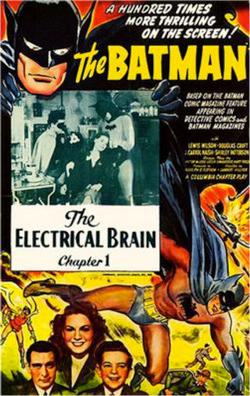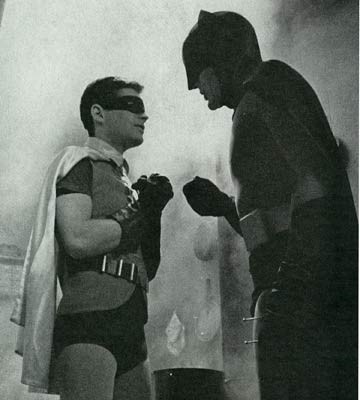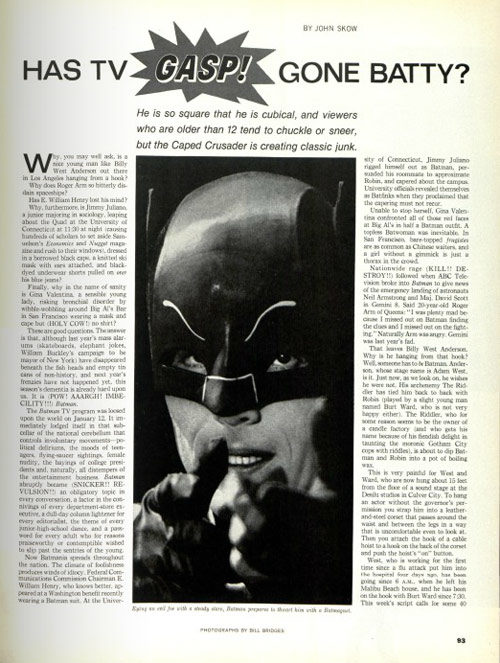Dark Knight, Dark Theater: 75 Years of Big-Screen Batman

Adam West. Michael Keaton. Val Kilmer. George Clooney. Christian Bale. Ben Affleck. Lewis Wilson. Wait . . . Lewis Wilson? That’s correct. The first actor to play Batman on the big screen, Wilson starred in the serial Batman, released 75 years ago this week in 1943.
The Columbia Pictures serial followed a pattern typical of the format at the time: There were 15 chapters of roughly 17 minutes each, with a new installment released weekly ahead of features at the theatres. While the black-and-white production might look cheap and dated to modern audiences, Columbia invested more in Batman than in any of their other pictures at the time, and gave it a marketing push equal to that of their regular features. Critics of superhero film hype probably need to start here.
Batman attracted positive attention from fans of the Caped Crusader because it remained faithful to the general principles of the comics created by Bob Kane and Bill Finger, among others. Unlike the Republic’s Captain America serial of 1944 — which changed Cap’s origin, secret identity, and costume and replaced his shield with a gun — the Columbia take on Batman took pains to stay close to the original. Batman was millionaire Bruce Wayne, Robin (played by Douglas Croft) was Dick Grayson, and Alfred was, well, Alfred (played by William Austin). In fact, after the serial’s success, the portly Alfred of the comics was changed to resemble the thin, mustachioed Austin. The serial indelibly added to the mythos by showing Batman and Robin operating out of a Batcave under Wayne Manor.
The original trailer for the 1943 Batman serial.
One notable change was a result of film censor rules of the time. Since various offices disapproved of vigilantism in films, Batman and Robin were given a government agent affiliation for the purposes of this particular adventure. It’s a minor thing in retrospect, and not terribly dissimilar to Batman’s relationship with the Gotham City Police Department in the later 1960s television series.
The plot’s pretty standard for action serials of the time: the villain, Dr. Daka, is the Japanese leader of an Axis saboteur ring, and Batman and Robin are out to stop him. What makes the serial stand out, apart from decent attempts at costumes, are set pieces that include the gadgetry and traps that would become hallmarks of Batman in the comics and on screens large and small. Daka meets his end falling through a trapdoor into a pit of crocodiles (although writer Roy Thomas used him in the 1980s for a brief run in All-Star Squadron, a book that dealt with DC heroes in World War II).

Columbia had a hit on its hands with Batman, and it led to the immediate green-lighting of a serial based on radio and comics character the Green Hornet. Unfortunately, The Green Hornet tanked at the box office, which was in part responsible for the delay in producing the Batman sequel, Batman and Robin, which didn’t come until 1949, with a different cast. Ironically, Green Hornet would, like Batman, later be featured in a TV show in the ’60s, and they would even cross over in a two-part episode in 1967.
For on-screen appearances, Batman remained on the bench through the ’50s, even as the comics continued their ongoing run. He hit the screen again in a big way in 1966, when Adam West brought him to life for the Batman TV series. As it hit new heights of popularity, The Post visited the set for the May 7, 1966 article “Has TV (GASP!) Gone Batty?”. The series ran for three seasons and spun off a feature film, Batman: The Movie, in 1966, as well.
After the campy show came to a close, Batman spent most of the ’70s and ’80s confined to animation, regularly appearing on the various seasons of The Super Friends from 1973 to 1986. West provided the voice of Batman for the final two seasons. West and Burt Ward (Robin) also reprised their roles for a pair of live-action specials in 1979.
But the big screen beckoned Batman again in 1989. Batman, starring Michael Keaton, Jack Nicholson (The Joker), and Kim Basinger (Vicki Vale), crushed the box office that summer, earning over $400 million. Warner Brothers launched a full-blown multimedia franchise at that point, including a rebooted animated take on the Dark Knight that resulted in subsequent spin-offs for Superman and the Justice League. The movies marched onward with Keaton again in Batman Returns (1992), Val Kilmer in Batman Forever (1995), and George Clooney in Batman & Robin (1997).
The first theatrical trailer for Batman Begins from 2005.
For a variety of reasons, Batman & Robin failed with the public. While the animation marched on, it would be eight years before another live-action Batman film. Director Christopher Nolan took the helm, assembling a cast of heavy hitters (Gary Oldman, Morgan Freeman, Liam Neeson, etc.) around Christian Bale as the lead in 2005’s Batman Begins. The hit film led to 2008’s The Dark Knight, a massive critical and commercial success fueled by the Oscar-winning depiction of the Joker by Heath Ledger, who would sadly die of an accidental overdose prior to the film’s release.
Batman continues to be a major film presence. After Nolan closed his trilogy with The Dark Knight Rises in 2012, a new version of the Caped Crusader emerged in Batman v. Superman: Dawn of Justice. The 2016 film gave us Ben Affleck in the role; he would return for Suicide Squad in 2016 and Justice League in 2017.
Presently, plans at Warner appear to be up in the air. Director Matt Reeves has the keys to the franchise and appears to want to, like Nolan, veer younger with his hero again. Whatever the case, it seems certain that Batman will never be gone from the big screen for long.
